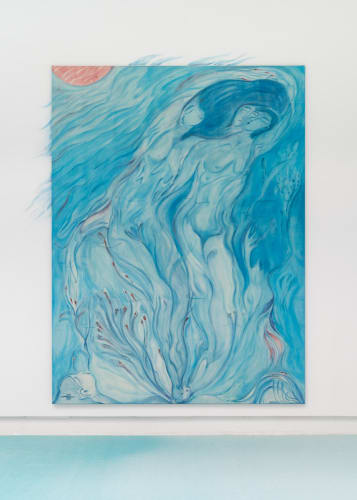In Kinga Bartis’s work, just about everything is in motion. Things we usually distinguish from each other flow together. The outline of a human body is blurred in the current of the ocean. Ocean slides into sky. The wind snatches the flapping wings of a bird, and the bird merges with the clouds. Bartis’s works are like ecosystems. It is impossible to view anything in isolation. The various elements are not demarcated by clear contours. They vibrate. But everything is not merely animated. Things are also interwoven to such an extent that they animate each other.
Shores of Selves at Tranen is Bartis’s first institutional solo exhibition. It presents a world in which everything has a self, but that self is in a state of change and has no line of demarcation. A thing may have a self, but may also share it with others. Bartis not only paints people, animals, plants, the sea, the sky and the celestial bodies in their own right. She also paints what they mean for each other. The place where one element ends and a new one begins is as fluid as the coast, where sea meets land – like embrace, like collision, like sex, like struggle. The same applies both to the paintings and the carpet in the exhibition. Yes, everything occupies its place, but everything also overflows into each other.
Bartis grew up as part of the Hungarian minority in Transylvania, Romania, and later as an immigrant in Hungary, where she took a master’s degree in social sciences, before moving alone to Denmark and embarking on her second period of study at the Academy of Fine Arts in Copenhagen. Her background has often led her to think of the sociologist Georg Simmel’s concept of the foreigner who feels alienated from their immediate environment: without a place to call home or a native language to express their lifeworld. Her most fluent language lies in her paintings. Here, culture, norms, boundaries, hierarchies, rules and even natural laws are shifting. However, although her biography may be one way of approaching her works, the works are not about a single life, but about several lives and forms of life.
In Bartis’s paintings, the human being is not merely indistinct and inseparable from their surroundings. In several works in Shores of Selves the human figure is multiplied. Bartis explores bodies, in which the individual appears like a sea of figures; or a sea of figures is engulfed and encased by just one body. Humans often assume familiar figures, but then they morph into unrecognizability. There is the maternal body, giving birth to and investing water plants with life. There is the sensual body, making love, not only to other bodies, but also to everything by which it is surrounded. There is the strikingly beautiful body, whose head and organs mutate monstrously and bud like a flower. Then comes a myriad of mouths, eyes, and vaginas, all of which are so open to the world that they are not rooted in any body at all. In the paintings, rootlessness is not just cultivated as loss, but as an opening to a rich space of possibility and ambiguity – as another way of thinking, of feeling, and of existing in the world. Just as there are examples in the plant and animal kingdoms of consciousness without brain, feelings without a central nervous system, and procreation without genitals.

